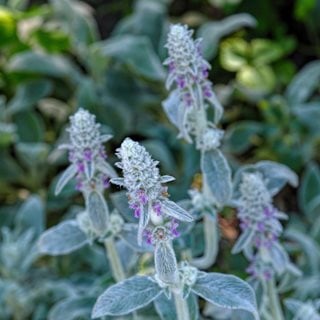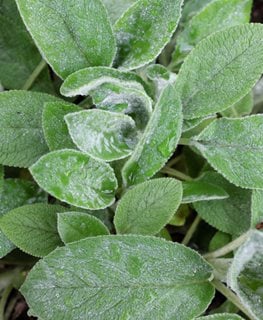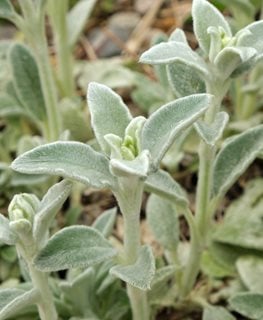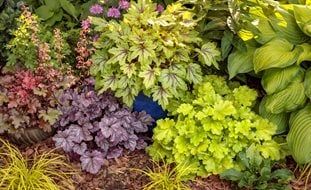Using Lamb's Ear in the Garden: Growing and Care Tips
Bring texture and softness to your garden designs with this unique foliage plant.The best gardens please all the senses, including our sense of touch. Lamb’s ear is one of those extraordinary perennials that feels as good as it looks, with leaves so soft and velvety that you can’t resist stooping down to caress them for the sheer joy of it.
Although this easy-care plant is usually grown for the attractive silvery-gray foliage, some varieties also send up showy spikes of purple or pink flowers in summer. Drought tolerant and fast growing, lamb’s ear is ideal for use as a ground cover, edging a sunny border, or in rock garden plantings. And of course, it’s a wonderful addition to a sensory garden because of its visual and tactile appeal.
On this page: Basics | Planting | Care | Varieties | Design Ideas
- BASICS
- HOW TO PLANT LAMB'S EAR
- LAMB'S EAR PLANT CARE
- LAMB'S EAR VARIETIES
- DESIGN IDEAS FOR USING LAMB'S EAR PLANTS
BASICS
Botanical name:
Stachys byzantina
Common names:
Woolly betony, donkey’s ears, woolly hedge nettle
Plant type:
Herbaceous perennial
Zones:
4-9
Exposure:
Full sun to partial shade
Growth habit:
Mounding, spreading
Height/spread:
4 to 18 inches tall, 12 to 36 inches wide
Bloom time:
Summer
Foliage:
Oblong to elliptical, densely hairy leaves are gray-green to silvery in appearance with a soft, downy feel.
Flowers:
Small two-lipped flowers bloom on upright stalks in various shades of pink and purple and, more rarely, white. Some cultivars are nonflowering.
Special attributes:
- The fuzzy foliage repels deer and rabbits
- Tolerant of black walnut toxicity
- Leaves remain evergreen in warm climates
- Heat and drought tolerant
- Flowers are attractive to bees and butterflies
Is lamb's ear invasive?
Although plants will spread readily in a favorable site via creeping stems, they are easily removed where not wanted and aren’t considered invasive. Flowering lamb’s ear varieties can also spread through self-sowing, which can be controlled by deadheading the flower stalks.
PLANTING LAMB'S EAR
When to plant:
In spring, after the danger of frost has passed, and up until early fall. If planting in fall, give plants enough time to establish roots before winter.
Where to plant:
Native to the Mediterranean, lamb’s ear grows best in full sun (at least 6 hours of sunlight daily) but can benefit from some afternoon shade in hot climates. Established plants will tolerate drought, which makes them a great choice for drier spots in the garden. If using as an edging plant, grow in a site where its spreading habit can be kept under control.
How to plant:
Dig a hole slightly larger than the plant’s container, then gently remove the plant and place it in the hole with the crown level with the soil surface. Backfill with soil, then water thoroughly. If planting in mass, space plants at least 12 inches apart, depending on their width at maturity, to ensure good air circulation and prevent overcrowding.
Growing in containers:
Because of its silvery foliage and downy texture, lamb’s ear is a nice alternative to dusty miller or artemisia in container combinations, acting as a cooling contrast to brightly colored flowering annuals. Be sure to plant in a high-quality all-purpose potting mix, using a container with drainage holes so the roots won’t get waterlogged. Pair only with plants requiring similar exposure conditions and water requirements.
LAMB'S EAR CARE
Learn more about growing lamb's ear in your garden, from Janey @digplantwaterrepeat.
Watering:
Give established plants about an inch of water a week during dry spells, keeping the foliage as dry as possible by watering at ground level. Avoid overhead watering, since the hairy leaves can trap water, leading to powdery mildew and other fungal diseases. Adding a layer of mulch around the base of your plants can also help prevent soil moisture from coming in contact with the leaves.
Amendments and fertilizer:
If you have compacted or heavy clay soil, amend it with compost or other organic matter to improve drainage. Lamb’s ear needs little nourishment to thrive, so fertilizing is generally unnecessary.
Pruning and deadheading:
To keep your plants looking neat and tidy, clip off the flower stalks at the base after the blooms fade in midsummer. Some gardeners prefer to prune off the flower stalks as they form so the plant’s energy remains focused on the foliage. Plants may also benefit from thinning in midsummer to expose them to more sunlight and to improve air circulation, which can reduce the chance for rot.
Dividing:
Lamb’s ear should be divided every three or four years in spring to prevent overcrowding and to improve plant health. Generally, you’ll know it’s time to divide your plants when they begin to die out in the center. Dig up the rootball and use a spade or sharp knife to divide into healthy, rooted sections, which can then be replanted or shared.
Propagation:
Can be propagated from seed (unless you’re growing a non-blooming variety) or by division.
Overwintering:
This hardy, cold-tolerant plant will withstand temperatures well below freezing without special protection, but the foliage will die back to the ground in areas with harsh winters. Wait until early spring to rake away the dead foliage, and when the weather and soil warm up, the plant will send up new, green growth.
Pests and diseases:
Lamb’s ear has few pest problems, but can develop root rot and foliar diseases in humid, overly wet conditions. Remove wilting or rotting leaves as soon as you see them and make sure the soil is well-drained.
LAMB'S EAR VARIETIES
DESIGN IDEAS FOR USING LAMB'S EAR PLANTS
- Use along sidewalks and garden pathways to soften the hard edges and to provide easy access for anyone who wants to reach down and gently stroke a leaf.
- Create a charming, pastel-themed cottage garden by combining lamb’s ear with plants with purple and pink blooms, such as roses, Russian sage, catmint, and salvia.
- Use as a groundcover or border plant in a moon garden, where the pale, silvery foliage will emit a luminous glow on moonlit nights.
- Plant around the base of a birdbath or garden statuary to create a soft, attractive framework.
- Because of its drought tolerance, lamb’s ear is a perfect addition to a waterwise garden along with other plants with low water needs, such as sedums, succulents, and ornamental grasses.









